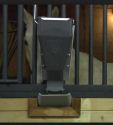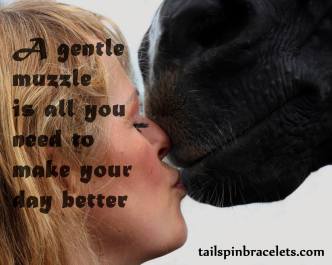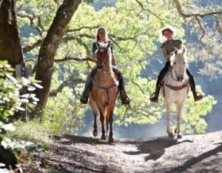 Whether you are building a new barn or redesigning your current barn, adding technology components can make your barn safer and your work more convenient. Consider adding these types of technology to your barn this year.
Whether you are building a new barn or redesigning your current barn, adding technology components can make your barn safer and your work more convenient. Consider adding these types of technology to your barn this year.
Intercom
If you have a large barn, you might want to consider installing an intercom system. An intercom can be useful for quickly reaching anyone in the barn with important messages. From asking grooms to bring out certain horses to reminding students that their lesson starts shortly, a barn intercom spreads information quickly and efficiently no matter how large your barn is!
Video Surveillance
Video surveillance is one of the most important technological investments that you should consider installing in your barn. Video surveillance can help to deter thieves, and may even reduce the cost of your property and business insurance. If you’re operating a boarding or training operation, the fact that your barn has video surveillance can be a reassurance to owners.
Stall video surveillance is another option. Can’t remember if you blanketed that last horse? Check via video. Anticipating a new foal? A video can keep an eye on the process until it’s time. Worrying that your horse may colic? Use a video to watch him through the night.
Hardwired Fire Alarm
If you’re not already planning to install a hardwired fire alarm in your barn, you should. The risk of fire in barns is significant, and you should absolutely invest in a quality fire alarm system. Additionally, contact your local fire department and find out if it’s possible to wire your fire alarm so that it sounds directly in the fire station itself. This feature can save valuable time in the event that a barn fire does break out.
Stereo Systems
Consider installing a stereo system in the viewing room so that anyone observing a lesson or training session in your indoor arena can hear the instructor’s comments. As long as the instructor uses a microphone, installing speakers in the viewing room can be a useful tool which allows everyone to clearly hear the session.
Many people enjoy riding to music. A stereo system for the arena can allow for dressage freestyle competitions. It is also useful if you are going to be holding shows at your facility.
Tack Room Alarm
Installing an alarm in your tack room is an excellent way to deter thieves. An alarm system offers your tack valuable protection, and provides you and any other horse owners with peace of mind each night. Installing a keyed alarm means that you can give the code to anyone who needs to access the tack room. With tack being one of the easier (and more valuable) items in a barn to steal and resell, the value of a tack room alarm can’t be overlooked.
 Automatic Feeders
Automatic Feeders
Making sure your horse has food throughout the day can sometimes be difficult. Using automatic feeders can insure your horse always has something to nibble on throughout the day.
Wi-Fi
Installing wi-fi at your barn is a great option to keep your boarders happy. Once they are done riding, they can keep up to date on emails and social media.
Technology products keep getting better and better while the prices keep dropping. You CAN afford to add technology to your barn!










 Having the option of having your horse on pasture board or turnout during the summer is great not only for your expenses, but for your horse as well. Horses are happiest being able to graze all day, preferably in the company of other horses.
Having the option of having your horse on pasture board or turnout during the summer is great not only for your expenses, but for your horse as well. Horses are happiest being able to graze all day, preferably in the company of other horses. protect them through the seasons. If your horse usually grows a good winter coat, he may be perfectly fine in stable that protects him from the cold and wet. You still may want to consider a lightweight waterproof sheet if he will be turned out in rainy/snowy weather. You may also want to consider whether to clip or not. Clipped horses can be cooled much more quickly after a hard ride, but the downside is that he will need to be blanketed. And sometimes double blanketed depending on your winter cold. I suggest several light layers instead of one heavy blanket so you can adapt his “wardrobe” to the temperature.
protect them through the seasons. If your horse usually grows a good winter coat, he may be perfectly fine in stable that protects him from the cold and wet. You still may want to consider a lightweight waterproof sheet if he will be turned out in rainy/snowy weather. You may also want to consider whether to clip or not. Clipped horses can be cooled much more quickly after a hard ride, but the downside is that he will need to be blanketed. And sometimes double blanketed depending on your winter cold. I suggest several light layers instead of one heavy blanket so you can adapt his “wardrobe” to the temperature. While we all dream of a big, beautiful, brand new horse trailer, sometimes the reality of finances has us looking at used horse trailers instead. The end of horse show season is often a great time to search out good used trailers, but you may have to look hard and long (and often near and far, too!) as well as be able to compromise on your dream list.
While we all dream of a big, beautiful, brand new horse trailer, sometimes the reality of finances has us looking at used horse trailers instead. The end of horse show season is often a great time to search out good used trailers, but you may have to look hard and long (and often near and far, too!) as well as be able to compromise on your dream list.  look at the condition of all these areas.
look at the condition of all these areas. Leasing a horse is an ideal way to see if you want the responsibility of owning your own horse. You have the responsibility of caring for the horse in addition to riding it and you can see if the time required to own your own horse fits with your lifestyle. Too often people are quick to buy a horse and then realize it’s too much work. Sometimes the horse suffers from neglect when stuck in his stall for days, or the owner wants to quickly sell the horse and isn’t that concerned about the buyer.
Leasing a horse is an ideal way to see if you want the responsibility of owning your own horse. You have the responsibility of caring for the horse in addition to riding it and you can see if the time required to own your own horse fits with your lifestyle. Too often people are quick to buy a horse and then realize it’s too much work. Sometimes the horse suffers from neglect when stuck in his stall for days, or the owner wants to quickly sell the horse and isn’t that concerned about the buyer. Other issues such as mandating wearing a helmet when riding or not going out on trails or what bit to use when riding are all additional questions that should be discussed before the lease begins. Only by being sure that both (or all) parties involved in the lease understand the rules can a lease be the ideal situation for all, including the horse.
Other issues such as mandating wearing a helmet when riding or not going out on trails or what bit to use when riding are all additional questions that should be discussed before the lease begins. Only by being sure that both (or all) parties involved in the lease understand the rules can a lease be the ideal situation for all, including the horse. Trail riding this time of year is a tr
Trail riding this time of year is a tr

 Pastern dermatitis, often known as scratches, is a common problem of inflammation of the skin behind or around the pastern of the horse. In most cases, the infection is caused by bacteria or a fungus that enters the skin through any openings in the skin – small wounds, cracks or even chapping. The most common signs of scratches are scabs and crusting around the pasterns. There may be a clear liquid substance leaking from the area.
Pastern dermatitis, often known as scratches, is a common problem of inflammation of the skin behind or around the pastern of the horse. In most cases, the infection is caused by bacteria or a fungus that enters the skin through any openings in the skin – small wounds, cracks or even chapping. The most common signs of scratches are scabs and crusting around the pasterns. There may be a clear liquid substance leaking from the area. Keep paddocks, shelters and all turnout areas dry. Since moisture is bad for the horse’s skin and is the leading cause of scratches, having him stand in wet grass or, even worse, ankle high mud is just asking for trouble. During wet weather, use a sacrifice area with well-drained footing like crushed gravel to help keep feet and pasterns dry. You can even use
Keep paddocks, shelters and all turnout areas dry. Since moisture is bad for the horse’s skin and is the leading cause of scratches, having him stand in wet grass or, even worse, ankle high mud is just asking for trouble. During wet weather, use a sacrifice area with well-drained footing like crushed gravel to help keep feet and pasterns dry. You can even use 
 pronounced, the shoulders sloping, and the chest deep. The back is medium-long and muscular, the croup is long, slightly sloping and well-muscled. The legs are clean, with broad, flat knees and powerful hocks. The Haflinger has rhythmic, ground-covering gaits. The walk is relaxed but energetic. The trot and canter are elastic, energetic, and athletic with a natural tendency to be light on the forehand and balanced. There is some knee action, and the canter has a very distinct motion forwards and upwards. An important consideration in breeding and what makes the Haflinger an ideal horse is its temperament. A requirement for a quiet, kind nature has become part of the official breed standard and this is part of any breed inspection.
pronounced, the shoulders sloping, and the chest deep. The back is medium-long and muscular, the croup is long, slightly sloping and well-muscled. The legs are clean, with broad, flat knees and powerful hocks. The Haflinger has rhythmic, ground-covering gaits. The walk is relaxed but energetic. The trot and canter are elastic, energetic, and athletic with a natural tendency to be light on the forehand and balanced. There is some knee action, and the canter has a very distinct motion forwards and upwards. An important consideration in breeding and what makes the Haflinger an ideal horse is its temperament. A requirement for a quiet, kind nature has become part of the official breed standard and this is part of any breed inspection.